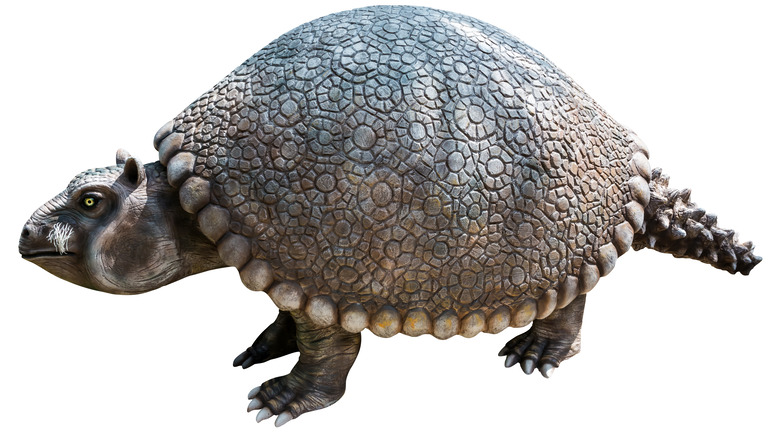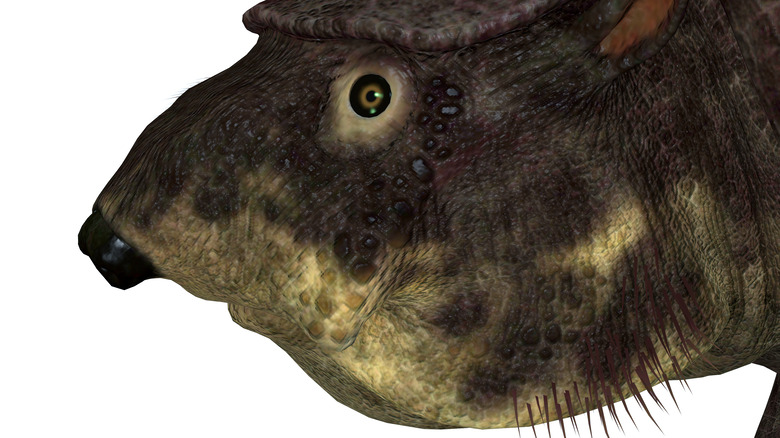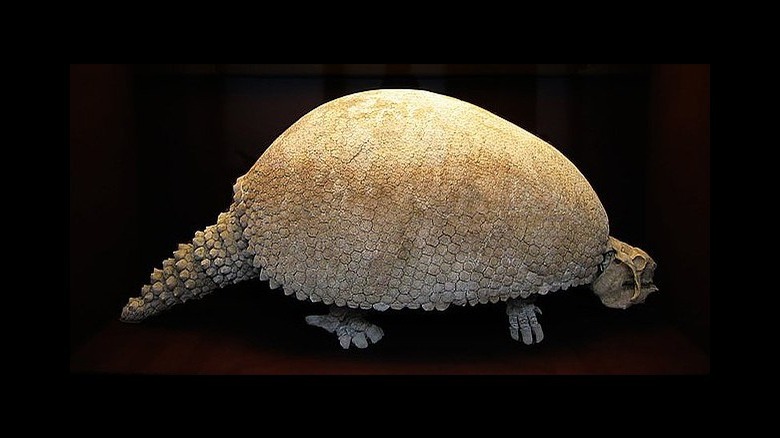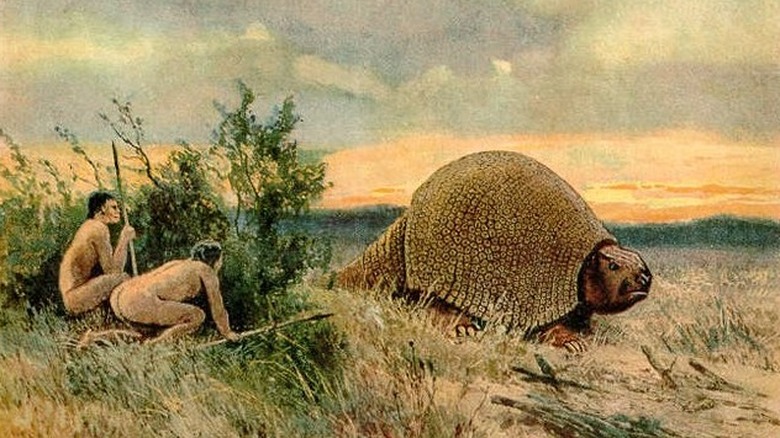Facts About The Extinct Glyptodon, The Giant Armadillo
Ancient history is full of a number of giant animals called megafauna, which are animals that weigh more than 100 pounds, according to American Scientist. One of the strangest and most unusual of all the megafauna species was the Glyptodon, or giant armadillo, which was just what it sounds like: an enormous ancient relative of the modern-day armadillo, covered in armored plates, per Britannica. From just how big Glyptodon really were to where they lived, what they ate, and what finally wiped them out, here are just a few fascinating facts about this unusual creature from Earth's history.
Many megafauna species, including the Glyptodon, survived until roughly 10,000 years ago. Isolated populations of woolly mammoths are thought to have lived until around 4,000 years ago, as USA Today reports. That's about the same time as the Pyramids of Giza in Egypt were built, per National Geographic. Surviving species of armadillo average less than 3 feet in length and typically weigh up to 12 pounds (via the National Wildlife Federation). Glyptodon were far different. To get a sense of what it might be like to come face-to-face with one, it's best to imagine a certain modern motorized vehicle instead.
The Glyptodon was about the same size as a U-Haul
Forget everything you know about the modern — and sometimes kinda cute — species of armadillos that still scurry around certain parts of the American Southeast, according to the National Wildlife Federation (NWF). To imagine just how large and heavy the Glyptodon were, think instead of a small U-Haul truck, which measures around 10 feet in length (via Measuring Stuff). That's roughly the same size as a Glyptodon.
As ThoughtCo. explains, the Glyptodon weighed about a ton, and their primary habitat was the South American swampland. Some Glyptodon fossils, though — as well as fossils of their close cousin, the glyptodont — have been found in North America, as Britannica notes. Per All That's Interesting, in the 1820s, a Glyptodon femur was discovered in Uruguay. At first, It was assumed the bone belonged to a giant ground sloth, another ancient species of megafauna.
Evidence of the Glyptodon carapace — or bony shell — soon followed. With that, scientists hypothesized they had a new species on their hands — some kind of giant armadillo — and they were right. The next question for Glyptodon researchers was what to call their discovery. Hoplophorus, Pachypus, Schistopleuron, and Chlamydotherium were all suggested (via ThoughtCo.). Influential English paleontologist Richard Owen, who died in 1892, proffered Glyptodon — or "carved tooth" in Greek. Thanks to Owen, that's what these titanic extinct creatures are called today.
A Hard Shell
As All That's Interesting (ATI) goes on to note, the Glyptodon carapace was more like the shell of a modern turtle than a typical armadillo, with many hundreds of "bony plates" fitting tightly together to create an impervious, armored outer layer. This feature meant the Glyptodon could withstand attack from most predators unless one was unfortunate enough to get rolled over onto its back, exposing its soft underside. They also had an armored cap protecting their heads, and their musculature suggests they had a small proboscis on their face, something like an elephant or tapir (via Kiddle).
Armored back aside, these tank-like creatures weren't just about defense: They could also go on the offensive. Glyptodon had massive tails, and in some Glyptodon species, those tails were covered in bony spikes, according to Britannica. Those tails were used to protect the Glyptodon's young and to ward off predators, like the smilodon species, or saber-toothed tigers, per National Geographic. Glyptodon tails are even known to have cracked the hard-shelled backs of their own kind, as ATI writes. But with short, squatty legs and a lumbering presence, these creatures were not known for their hunting prowess and were herbivores, according to ThoughtCo and ATI.
Glyptodon lived alongside humans
Thought to have gone extinct around 10,000 years ago, as with many other species of megafauna, Glyptodon in some parts of the Americas lived alongside indigenous human populations who, according to many estimates, arrived on the scene around 14,000 years ago (if not earlier), according to Smithsonian Magazine. It's safe to imagine, then, that spotting a Glyptodon in those early landscapes was not uncommon and some evidence suggests these creatures were hunted by humans at that time, most likely with spears. Scientists believe the Glyptodon went extinct due to over-predation, according to ThoughtCo. Some evidence also suggests early inhabitants in North and South America used the spacious, bony carapace for shelter.
As well as the smilodon, other Glyptodon predators included the dire wolf, short-faced bear, and terror bird, according to Kiddle. All that, combined with climate change, likely drove the giant armadillo to oblivion. Think of that next time you see one of the Glyptodon's only living relatives: the pink fairy armadillo, which, unlike their gigantic, extinct ancient cousins, reach lengths of only around 6 inches, according to the World Wildlife Fund.



